Sugarloaf + Social Media + PR
December 28, 2010
Social Media + Crisis Management PR
Today at Sugarloaf (Level8's favorite Maine ski mountain), an incident occurred. The following analysis is focused on the how the mountain handled the incident, rather than the specifics of the incident that occurred. However, to properly represent the severity and potential impact of the day's happenings, it is important to know that at the time at which this article was written it is understood that the Spillway chairlift has been derailed with guests aboard, six or more people have been reported injured.
Social Media
Social media offers companies direct and instant communications with their publics, also allowing the public direct contact back to companies. These interactions are enabled through evolving technologies, and the potential of these interactions are constantly being explored and expanded.
When discussing the value of social media with clients, so often the conversation is limited to how you can use social media outlets to promote a brand and expand a company's audience. The challenge is often how to get your customers to engage on your company's Facebook activity, how to make them feel apart of your brand. It wasn't until today that I witnessed a company's response to a PR crisis through social media, how their audience utilized the tools available to communicate back, and the new PR challenges companies face.
Crisis Manage PR - Through Social Media
By eliminating intermediaries (tv, news papers, radio) companies are now able to instantly communicate to their audiences, through these same outlets their audiences are able to instantly and publicly inform companies of issues and concerns. Let's look at the Sugarloaf incident and how it unfolded in social media.
Apx - 10:30am - 12/17/10
Spillway chair is derailed stranding many, injuring some.
Apx 11:30
The first related Facebook message appears. Shortly after, people start commenting. One individual who appears to have been on the lift writes in, promoting a news reporter to inquire further.
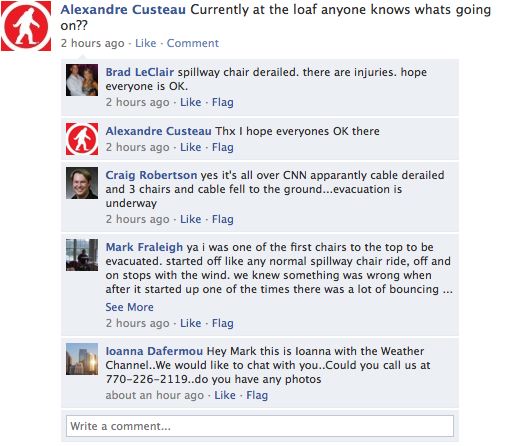
The news article which origanated from this Facebook post
Apx 11:30-12:00
Because Facebook timestamps are only accurate to the minute within the first hour, it's hard to properly asses the timing of the chronology, however we can see that Facebook in this case responded second, after the previous individual's post. Sugarloaf's post as seen, received a tremendous out pouring of responses, certainly much more than the previous individuals post. Why did people respond more to Sugarloaf's post that the other individuals?
Let's look at some of the immediate comments that were made by people in response to the initial post by Sugarloaf. Alex C alludes to the fact there might have been unaddressed issues with the lift, while Mary offers a more detailed description of the events "actual" happenings. People go on to offer thanks to Sugarloaf for posting, while others seem to reprimand the mountain for not having the lift on wind hold. Interestingly, not all comments are negative, many seem focused on prayers and hope. However, the comments made by people like that of John D. "I just heard there were fatalities…" are the type which I sure make the Sugarloaf PR managers cringe. This type of comment instills fear, offers no source of information, and acts only to exacerbate the immediate situation.
Sugarloaf's Facebook Page
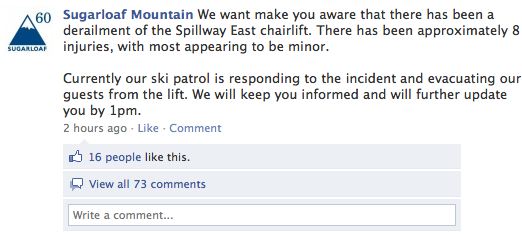
Sugarloaf's Facebook Page
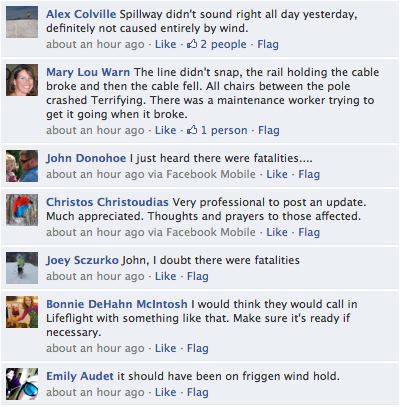
Apx 12:00
News reporters are now on the scene (the Facebook scene that is) trying to harvest local knowledge of the story. Interestingly, they news team is now acting under their Facebook Page oppose to using an individuals account as we previously saw.
Sugarloaf's Facebook Page

Apx 12:30
Twitter is alive with action. Much like the Facebook page we are seeing several different attitudes exposed, though at a much higher volume. The reason for the volume I would assume is that we are searching all peoples Tweets regarding sugarloaf, oppose to their Facebook page where we are viewing a single site of commentary.
Twitter Results For "Sugarloaf" Search

Apx 1:00
Sugarloaf releases its first press release about an 1.5 hours after the Facebook conversation first started, and 2.5 hours since the incident occurred. I would be interested to know what percentage of their public digested this information from the link within their Facebook and Twitter accounts oppose to more conventional media sources.
Sugarloaf's Facebook Page
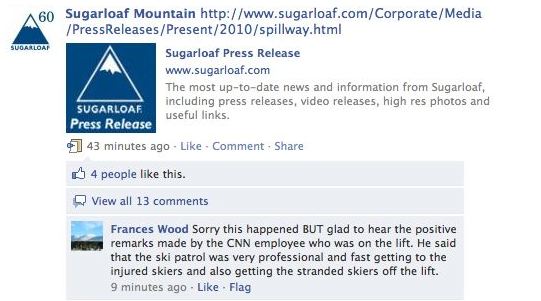
Sugarloaf's Twitter Page
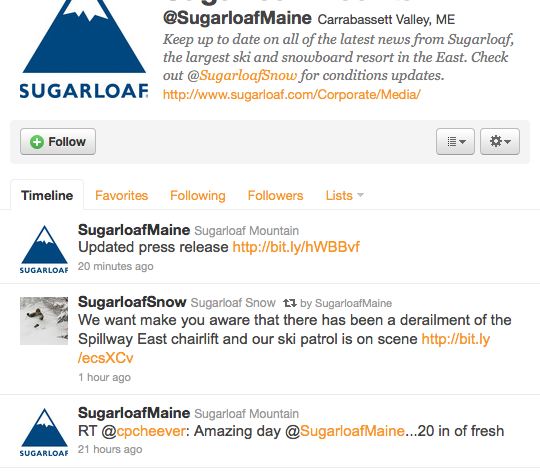
Apx 1:30
Sugarloaf appears to have disabled the ability for users to "share" on the Sugarloaf Facebook wall. They can however still comment on existing posts.
3:00pm, Time of Writing
This brings us to the time this was written, and leaves a lot of questions as to the future role of social media in PR. While I see no glaring misstep by Sugarloaf, I wonder if there are advantages to removing the ability for users to "share" on the company's wall. Similarly, I'm curious if Sugarloaf deleted any individuals postings to their wall, potentially filtering out misleading rumors or false statements. If they didn't filter postings, why not?
Is social media the proper first response? With the ability to so quickly put information in front of the public, is instant too quick? It would appear in this case that the Sugarloaf Facebook administrator didn't immediately rush to post, due not only to the time of their first post but also the message. It would be easy to imagine a case where the initial message might not be premeditated and result in backlash.
As our culture relies more on instantaneous responses, this topic will continue to evolve. No doubt influenced by developing technologies, social media may soon become (if it isn't already) a prime focus for public relations specialist, and the companies they represent.




